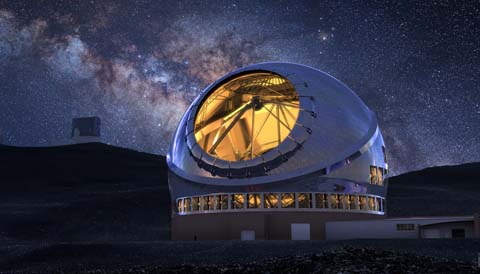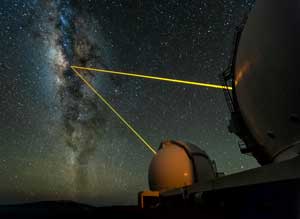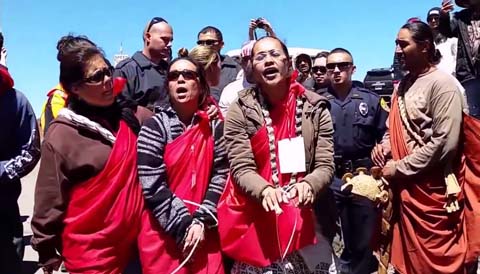Maunakea Observatories Shuttered Amid Protests – Sky & Telescope
As protests against the construction of the Thirty Meter Telescope continue, the directors of the Maunakea Observatories have taken the unprecedented move of closing all observatories atop the mountain.

An artist’s portrayal of how the Thirty Meter Telescope would look once completed.
National Astronomical Observatory of Japan
Last week, Governor David Ige and Thirty Meter Telescope(TMT) officials announced that construction of the megatelescope would begin on July 15th. However, for the last several days, Hawaiian activists have blocked the Mauna Kea Access Road, preventing the passage of construction vehicles.
The protests have remained peaceful, even as 33 kūpuna (respected elders) as well as one caregiver were arrested on Wednesday. However, citing the desire for safety for all people involved, the directors of the existing observatories atop Maunakea have shuttered the telescopes for the time being and brought all personnel — 25 people from five observatories — down from the summit.
“We stepped out of the way for the time being,” Rich Matsuda, chief of operations at the W. M. Keck Observatory, told Sky & Telescope.

Lasers shot from the W. M. Keck Telescopes on Maunakea create an artificial star in Earth’s atmosphere that allows astronomers to measure the atmosphere’s blurring effect and correct for it as they observe by slightly deforming the telescopes’ mirrors.
© 2012 Ethan Tweedie Photography
These existing telescopes and their associated instruments are some of the largest and most advanced in the world, including Gemini, the twin Kecks, and Subaru. (Click here for a full list of observatories on the summit.)
“This is not a decision we came to lightly, but want to emphasize the importance of safety for our staffs and the facilities,” said Jessica Dempsey, Deputy Director of the East Asian Observatory in a statement. (Watch video.)
While remote observing is possible, it’s risky, as personnel may not be able to attend to problems that might arise with computers or instrumentation. Even closing the observatories carries some risk, as many of the instruments are cryogenically cooled and require daily attention. The instruments are delicate and an uncontrolled warm-up could cause damage, Matsuda notes.
“We are working with law enforcement. They have a difficult situation facing them, and we feel they’re doing a good job of keeping everyone safe and peaceful,” Matsuda adds. “We’ll follow their lead; when they indicate situations are such that we can return, we will. We are playing it day by day.”

Arrested protesters chant before police remove them from the summit of Mauna Kea on April 2, 2015.
Occupy Hawaii
It’s unclear how the situation will resolve. Protests have continued in one form or another since 2014; opposition began building as early as 2009, when the Maunakea site was selected for construction. The persistence of the opposition is testament to the fact that much more is at stake here than the building and operation of a gigantic and revolutionary telescope. Nor is it simply about science versus religion and culture. To be sure, Maunakea, also known by its original name Mauna a Wakea (Mountain of the god Wakea), is sacred to Hawaiians. It represents a place where Earth and the heavens meet. But wrapped in with this devotion to the mountain is the sovereignty of the Hawaiian people.
“They’re utilizing the funds of the people, to protect the rights of foreign investors over the rights of the people of this place,” activist Kaho‘okahi Kanuha told Big Island Now.
Matsuda says that the ongoing tensions are painful for all involved. “Observatory workers have been part of the communities of this island for five decades,” he notes. “We have family members, good friends, people who we go to church with or clubs with, that have a wide range of perspectives. We’re very embedded into the community. Those conversations are happening at the family level. . . . It’s very difficult.”
Maunakea Observatories are working to show that culture and science may go hand in hand. The famous interstellar object ‘Oumuamua is so named because of a 2018 pilot program known as A Hua He Inoa, which brought together local students, Hawaiian language teachers, practitioners of traditional culture, and scientists to name astronomical objects in the traditional Hawaiian context — names that were then recognized by the International Astronomical Union.
Timeline of the protests so far:
July 15: Hundreds of protestors gathered at the bottom of the Mauna Kea Access Road to block construction vehicles. Kūpuna sat near several protestors who had chained themselves to a cattle guard, blocking road access. However, protests were peaceful and the state held off from making arrests, citing health and safety reasons.
July 16: Crowds dwindled, according to KITV’s Eliza Larson, but protests continued at the base of the access road. No construction vehicles were visible. NASA Infrared Facility Telescope astronomers were able to pass through the blockade to access the summit. Later in the day, however, directors of the Maunakea observatories jointly decided to bring all personnel down off the mountain, citing safety reasons associated with the blocked access road.
July 17: The third day began with 1,000 protestors gathering at the mouth of the access road, according to state estimates. Between 8 a.m. and 11 a.m. local time, police arrested 34 protestors, including 33 kūpuna and one caregiver. (Watch video.) Those arrested were issued citations for the misdemeanor charge of obstruction of a government operation. Between 11:15 a.m. and 2:40 p.m., the Hawai‘i County Police Department temporarily closed a 30-mile stretch of the Daniel K. Inouye Highway around the base of the Mauna Kea Access Road, due to cars and people on the highway. The road reopened once the cars and people moved. At 3:30 p.m., Governor David Ige announced he had signed a proclamation declaring a state of emergency for the area of Maunakea, which he said would offer more flexibility to authorities.
July 18: Peaceful protests continued for a fourth day. Kūpuna involved in the TMT protests held a press conference decrying the governor’s emergency proclamation. Meanwhile, the Department of Land and Natural Resources held a separate press conference announcing that foot traffic is no longer being allowed along the Maunakea Kea Access Road past the cattle guard. Dan Dennison, Senior Communications Manager, said no further arrests would be made unless protestors blocked the roadway or committed a crime.
To keep up with the situation as it develops, see the following local news sites:





